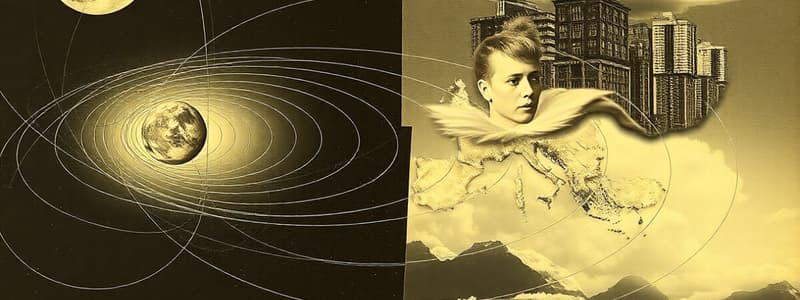Podcast
Questions and Answers
If a sailor is stranded at 45° South latitude, which wind belt would most likely help them sail eastward?
If a sailor is stranded at 45° South latitude, which wind belt would most likely help them sail eastward?
- Polar Easterlies
- Tropical Easterlies
- North-East Trade Winds
- Prevailing Westerlies (correct)
Which of the following statements best describes the relationship between the Hadley cell and the trade winds?
Which of the following statements best describes the relationship between the Hadley cell and the trade winds?
- The Hadley cell is driven by the polar easterlies, which in turn create the trade winds.
- The trade winds are a result of the rising air at 60° latitude in the Hadley cell.
- The Hadley cell is characterized by rising air at the Equator and sinking air at 30° latitude, causing air to move towards the Equator as trade winds. (correct)
- The trade winds deflect air from the Ferrel cell towards the Equator, forming the Hadley cell.
In which of the following locations would you expect to find a high-pressure zone?
In which of the following locations would you expect to find a high-pressure zone?
- Around 60° North and South latitudes
- At the North and South Poles (correct)
- At the Equator
- Along the Intertropical Convergence Zone (ITCZ)
Which of the following statements best explains the relationship between air pressure zones and global wind patterns?
Which of the following statements best explains the relationship between air pressure zones and global wind patterns?
A pilot flying from west to east at 50° North latitude experiences a strong tailwind. Which wind system is most likely responsible for this?
A pilot flying from west to east at 50° North latitude experiences a strong tailwind. Which wind system is most likely responsible for this?
How does the Coriolis effect influence global wind patterns?
How does the Coriolis effect influence global wind patterns?
Which of the following describes the primary difference between the North-East and South-East Trade winds?
Which of the following describes the primary difference between the North-East and South-East Trade winds?
Considering the relationship between pressure belts and climate, which region is most likely to experience arid conditions?
Considering the relationship between pressure belts and climate, which region is most likely to experience arid conditions?
Which of the following is the primary cause of the differential heating of the Earth that drives global wind patterns?
Which of the following is the primary cause of the differential heating of the Earth that drives global wind patterns?
If a sailing ship is traveling from Europe to America, which prevailing winds would be most beneficial for its journey, and why?
If a sailing ship is traveling from Europe to America, which prevailing winds would be most beneficial for its journey, and why?
Flashcards
What are Wind Belts?
What are Wind Belts?
Air movement from high to low pressure zones, creating prevailing winds.
Differential Heating
Differential Heating
Uneven solar heating of Earth, with the Equator receiving more direct sunlight than the poles.
ITCZ
ITCZ
A low-pressure zone near the Equator where warm air rises.
Subtropical Highs
Subtropical Highs
Signup and view all the flashcards
Coriolis Effect
Coriolis Effect
Signup and view all the flashcards
Hadley Cell
Hadley Cell
Signup and view all the flashcards
Ferrel Cell
Ferrel Cell
Signup and view all the flashcards
Polar Cell
Polar Cell
Signup and view all the flashcards
Tropical Easterlies (Trade Winds)
Tropical Easterlies (Trade Winds)
Signup and view all the flashcards
Prevailing Westerlies
Prevailing Westerlies
Signup and view all the flashcards
Study Notes
- Wind is air movement across Earth's surface from high to low-pressure zones.
- Permanent high and low-pressure zones cause consistent wind patterns called prevailing or planetary winds.
Planetary Pressure Belts
- Three planetary pressure belts result in three types of prevailing winds: easterlies, westerlies, and trade winds.
- Pressure belts influence weather, and prevailing winds cause seasonal climate changes.
- Low-pressure areas correlate with high precipitation, like the rainforests along the Equator.
- High-pressure areas correlate with arid climates, where most deserts are located.
Causes of Global Wind Patterns
- Uneven solar heating, where the Equator receives more heat than the poles, causes differential heating.
- Warm equatorial air rises and moves towards the poles, creating the Equatorial Low-Pressure Zone, also known as the Intertropical Convergence Zone (ITCZ).
- Air cools and descends around 30° north and south, creating Subtropical High-Pressure Zones.
- Cold air descends at the poles, creating Polar High-Pressure Zones.
- Polar air moves towards the Equator but rises around 60° north and south.
- Earth's rotation deflects winds to the right in the Northern Hemisphere and to the left in the Southern Hemisphere; this is called the Coriolis effect.
Atmospheric Circulation Cells
Hadley Cell
- Located between 0° and 30° north and south.
- Air rises at the Equator and sinks at 30° north and south.
- Winds move towards the Equator and are called Easterlies or Trade Winds.
Ferrel Cell
- Located between 30° and 60° north and south.
- Air rises at 60° north and south and sinks at 30° north and south.
- Winds move towards the poles and are called Westerlies.
Polar Cell
- Located between 60° and 90° north and south.
- Air rises at 60° north and south and sinks at 90° north and south.
- Winds move towards the Equator and are called Polar Easterlies.
- High and low-pressure patterns, including wind movement, occur in both hemispheres
Types of Wind Belts
- Three main types of prevailing winds include easterlies, westerlies, and polar easterlies.
- Wind names indicate the direction from which they originate.
Tropical Easterlies
- Also known as trade winds, these were historically used by European traders sailing to the "New World".
- These winds blow between 30° north and south towards the Equator.
- In the Northern Hemisphere, they are called north-east trade winds, and in the Southern Hemisphere, they are called south-east trade winds.
- Trade winds converge at the Equator, forming the Intertropical Convergence Zone (ITCZ), characterized by rising air and little wind. ITCZ is located +/- 5° of the equator
- The ITCZ was known as the "doldrums" due to ships being stranded without wind.
Prevailing Westerlies
- Blow between 30° and 60° latitudes (north and south) towards the poles.
- In the Northern Hemisphere, westerlies come from the southwest and are called south westerlies.
- In the Southern Hemisphere, westerlies come from the northwest and are called north westerlies.
- Ships returning to Europe would catch the westerlies across the Atlantic Ocean.
Polar Easterlies
- Blow from the polar regions to around 60° north and south.
- These cold winds rise around 60°, creating low-pressure zones called polar fronts.
Studying That Suits You
Use AI to generate personalized quizzes and flashcards to suit your learning preferences.
Description
Explore global wind patterns caused by pressure belts. High and low-pressure zones create prevailing winds like easterlies, westerlies, and trade winds. These winds influence weather and contribute to climate changes, affecting precipitation and aridity worldwide.




